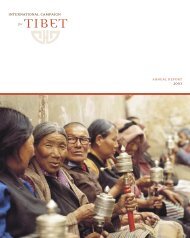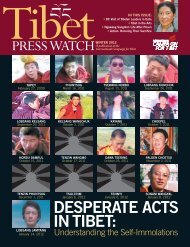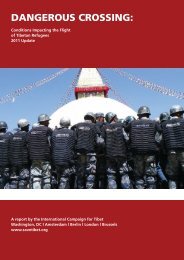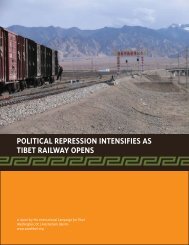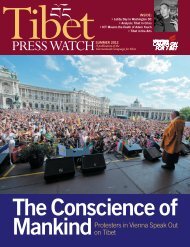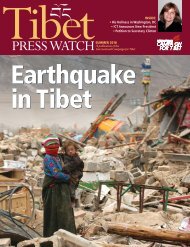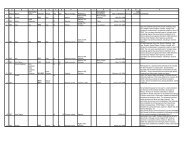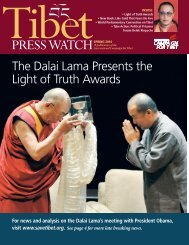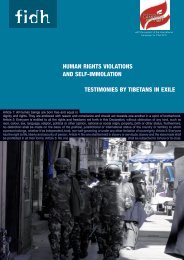Rukhag 3: The Nuns of Drapchi Prisonus and who teach us <strong>the</strong> exercises. If we rebuke officials who talk to us, <strong>the</strong>y immediately come with <strong>the</strong> wujin. Theyare always on standby.” 115Pema Butri’s accusation that <strong>the</strong> “old rukhag 3” nuns had been able to muster <strong>the</strong> energy to shout slogans only because <strong>the</strong>yhad received so much prison care echoed her denunciation four days earlier in “new rukhag 3”. Previous instances show that<strong>the</strong> phrase is clearly perceived as inflammatory by political prisoners. Norzin Wangmo’s account of <strong>the</strong> beating administeredafter she and her cell mates were taken into <strong>the</strong> “old rukhag 3” courtyard relays similar wording:“Then we were taken out, and again people came and we were beaten. It wasn't possible to stop <strong>the</strong> beating, wewould just cover our heads with our hands. They mostly hit us on our heads. They beat us saying, ‘You shouted.The Chinese government and Party gives you food and clothing. What else do you need?’.” 116Once <strong>the</strong> women had been brought out into <strong>the</strong> courtyard, a general beating by PAP began:“[T]he doors were opened and we were all taken into <strong>the</strong> courtyard and beaten. O<strong>the</strong>rwise we were each kept in ourcells. There is a small courtyard and that is where we were taken. We were taken <strong>the</strong>re and beaten <strong>the</strong>re. Therewere more than 20 people [who beat us]. Anyone who had hands was beating us. [...] They beat us so savagely that<strong>the</strong>re was blood everywhere, on <strong>the</strong> walls and on <strong>the</strong> floor. It looked like an abattoir. They beat us with <strong>the</strong>ir belts,until <strong>the</strong>ir belts broke due to <strong>the</strong> beating. Then <strong>the</strong>y used electric batons. [...] Some [of us] had torn ears, o<strong>the</strong>rs hadwounds in <strong>the</strong>ir heads. There was so much blood. When we went back to <strong>the</strong> cells we felt dizzy. It is not possibleto say that one or two had something particular, all of us were harmed. Now, when we say that here, that everyonewas like that, you can hardly believe it.” 117Using lea<strong>the</strong>r belts and buckles in this manner finds precedent in <strong>the</strong> Great Proletarian Cultural Revolution, when it wascommon <strong>for</strong> a single person, <strong>the</strong> object of political castigation, to be beaten by groups of Red Guards wielding belts in <strong>the</strong>manner described by Unit 3 prisoners. Norzin Wangmo’s account of <strong>the</strong> beating also features PAP use of <strong>the</strong>ir belts:“They beat us with <strong>the</strong> [buckle] of <strong>the</strong> belt. They struck every part of our bodies, but mainly our heads. They beatus [as a group] <strong>for</strong> two hours. Then <strong>the</strong>y beat us separately. Most of us were healthy be<strong>for</strong>e. After this some walkedaround with arms [in slings], and o<strong>the</strong>rs walked with a limp.” 118According to several accounts received by TIN, Pema Butri was personally involved in <strong>the</strong> beating from <strong>the</strong> time she led <strong>the</strong>security detail into “old rukhag 3”. At first <strong>the</strong> beating was generalised, though <strong>the</strong> women allege that Pema Butriendeavoured to participate in <strong>the</strong> beating of virtually all <strong>the</strong> prisoners be<strong>for</strong>e shifting her focus to specific inmates. “She beateach and every one of us,” explained Choeying Gyaltsen. “After she had beaten us, she took out <strong>the</strong> women that she didn't119like and she beat <strong>the</strong>m.” Ano<strong>the</strong>r nun present in <strong>the</strong> courtyard estimated that Pema Butri singled out about ten nuns <strong>for</strong>extra beating. 120Ngawang Sangdrol was <strong>the</strong> first prisoner to be singled out in this way. Pema Butri was convinced that she, along with SharBumpa nun Choekyi Wangmo (ordained Lobsang Choekyi), had engineered <strong>the</strong> protest. They would later become <strong>the</strong> onlyinmates of “old rukhag 3” to receive sentence extensions <strong>for</strong> <strong>the</strong>ir alleged role in <strong>the</strong> protest. “They were taken out and beatena lot. She beat <strong>the</strong>m badly, and <strong>the</strong> soldiers beat <strong>the</strong>m, kicked <strong>the</strong>m.” Accounts received by TIN all concur that no singleperson organised <strong>the</strong> protest and that it occurred entirely spontaneously. Choeying Gyaltsen reveals her indignation regarding36
Unit 3 and <strong>the</strong> Drapchi protests of May 1998Pema Butri’s accusation that <strong>the</strong> nuns had acted only because <strong>the</strong>y were prompted by one or two o<strong>the</strong>rs: “We are not sistersfrom <strong>the</strong> same parents. If anyone plans something, we won't listen. We shouted as a result of our personal thoughts.” 121It is a central feature of Chinese political culture to differentiate between leaders and followers, whe<strong>the</strong>r or not such adistinction is necessarily valid. A system that claims legitimacy on <strong>the</strong> basis of representing <strong>the</strong> collective people cannotcom<strong>for</strong>tably accommodate <strong>the</strong> notion of unpopularity. Popular movements considered to be threatening by <strong>the</strong> Party arecommonly attributed to <strong>the</strong> leadership of “very small” numbers of people who may face criminalisation and punishment.Perceived followers are offered a chance to admit <strong>the</strong> error of <strong>the</strong>ir ways, and receive leniency by doing so. Window-breakingand slogan-shouting in “old rukhag 3”, mirroring <strong>the</strong> larger issue of <strong>Tibet</strong>an nationalism, are likely to have been characterisedby <strong>the</strong> authorities as an instance of one or two hostile leaders and numerous misguided followers.Norzin Wangmo describes what she saw happen to Ngawang Sangdrol:“Ani Sangdrol was in <strong>the</strong> worst condition. It was like she was dead, she had lost consciousness. They didn't haveany proof against Ani-la, <strong>the</strong>y beat her out of grudge. Ani Sangdrol couldn't stand up. [They] said: ‘Rigchog, standup’, but she could not. Rigchog is what <strong>the</strong>y call Sangdrol. We thought that she was dead, and so did <strong>the</strong> tutrang,who said said, ‘Don't hit [her]’. Then Pema Butri came <strong>for</strong>ward and struck [her] again with her belt. [NgawangSangdrol] suddenly regained consciousness, and Pema Butri said, ‘I thought you had died, but you still didn't die.You! Stand up!’ We [were <strong>for</strong>bidden] to move. We had to wait a long time <strong>for</strong> her to stand up. When she did shewas bleeding heavily, blood was streaming from her like water. There were three or four wounds on her head. Shewalked with a limp. They had trampled upon her body. There were so many people beating [her] that we couldn'tsee her when she had fallen down. She wasn't even able to lift up her head afterwards.” 122Ano<strong>the</strong>r of Pema Butri’s targets was Choekyi Wangmo, a nun who looked younger than her age of mid-twenties and wasdescribed by one of her companions as “very small physically”. While she was being held at Gutsa be<strong>for</strong>e sentencing, severebeatings had left her with a limp in one leg and her injuries <strong>report</strong>edly required abdominal surgery. Of Choekyi Wangmo’scondition on 4 May, Norzin Wangmo recalls, “After <strong>the</strong> beating, when she stood up she was not like a human being.” 123Chubsang nun Ngawang Choezom (lay name Pasang Lhamo), whose five year sentence had been extended to 11 <strong>for</strong>contributing to <strong>the</strong> song cassette in June 1993, was ano<strong>the</strong>r recipient of violent treatment from Pema Butri. NgawangChoezom had been named as an instigator of <strong>the</strong> day's protest by a criminal prisoner, one of several who had been distributedamong <strong>the</strong> cells of “old rukhag 3” to monitor political prisoners in exchange <strong>for</strong> reduced sentences. O<strong>the</strong>r nuns insisted that<strong>the</strong> charge was fabricated. According to Norzin Wangmo, Pema Butri arrived at <strong>the</strong> cell and ordered <strong>the</strong> prisoners to standagainst <strong>the</strong> wall be<strong>for</strong>e dealing with Ngawang Choezom:“Pema Butri came into <strong>the</strong> cell. She shouted, ‘Hey, Pasang Lhamo’, and shoved Pasang Lhamo onto <strong>the</strong> floor. In one crashon <strong>the</strong> cement floor, <strong>the</strong> blood streamed out of her head. [...] and she [temporarily] lost consciousness when her head hit <strong>the</strong>floor. Then <strong>the</strong>y hit her with a belt. When she was hit with <strong>the</strong> belt she covered her face with her hands. The flesh was tornon her hands. Blood flowed from her face and everywhere.” 124TIN’s sources have mentioned o<strong>the</strong>r nuns as having been individually attacked by Pema Butri on 4 May. One was PhuntsogZangmo (lay name Yeshe Yangga)125, a Garu nun and cell mate of Ngawang Choezom. Although Pema Butri focussed onbeating Ngawang Choezom when she entered <strong>the</strong> cell, accounts suggest that Phuntsog Zangmo may have said something37
- Page 4 and 5: Tibet Information NetworkTibet Info
- Page 8 and 9: Table of Contents1. Introduction ..
- Page 10 and 11: Image 15: Gyabdrag Nunnery, in the
- Page 12: Rukhag 3: The Nuns of Drapchi Priso
- Page 15 and 16: Female political prisoners at Drapc
- Page 17 and 18: Female political prisoners at Drapc
- Page 19 and 20: Female political prisoners at Drapc
- Page 21 and 22: Female political prisoners at Drapc
- Page 23 and 24: Female political prisoners at Drapc
- Page 25 and 26: Female political prisoners at Drapc
- Page 27 and 28: Female political prisoners at Drapc
- Page 29 and 30: Female political prisoners at Drapc
- Page 31 and 32: Female political prisoners at Drapc
- Page 33 and 34: Female political prisoners at Drapc
- Page 35 and 36: Female political prisoners at Drapc
- Page 37 and 38: Unit 3 and the Drapchi protests of
- Page 39 and 40: Unit 3 and the Drapchi protests of
- Page 41 and 42: Unit 3 and the Drapchi protests of
- Page 43 and 44: Unit 3 and the Drapchi protests of
- Page 45: Unit 3 and the Drapchi protests of
- Page 49 and 50: Unit 3 and the Drapchi protests of
- Page 51 and 52: Unit 3 and the Drapchi protests of
- Page 53 and 54: Unit 3 and the Drapchi protests of
- Page 55 and 56: Unit 3 and the Drapchi protests of
- Page 57 and 58: Unit 3 and the Drapchi protests of
- Page 59 and 60: Unit 3 and the Drapchi protests of
- Page 61 and 62: Unit 3 and the Drapchi protests of
- Page 63 and 64: Unit 3 and the Drapchi protests of
- Page 65 and 66: Unit 3 and the Drapchi protests of
- Page 67 and 68: Unit 3 and the Drapchi protests of
- Page 69 and 70: Conclusion4. ConclusionThe women no
- Page 71 and 72: Appendices5. AppendicesPrisoner lis
- Page 73 and 74: Appendices500Tibetan political pris
- Page 75 and 76: List 2: Drapchi Prison: Unit 3 nuns
- Page 77 and 78: TIN# status code name lay name det.
- Page 79 and 80: List 4: Female political prisoners
- Page 81 and 82: TIN # status code name lay name det
- Page 83 and 84: TIN# status code name lay name det.
- Page 85 and 86: TIN # status code name lay name det
- Page 87 and 88: TIN # status code name lay name det
- Page 89 and 90: List 8c: Male Tibetan political pri
- Page 91 and 92: List 10: Female political prisoners
- Page 93 and 94: 4 495-0442 REL Ngawang Tenzin Yangd
- Page 95 and 96: 95-0074 REL Tsultrim Choedron Tseri
- Page 97 and 98:
EndnotesPrefecture, to the west of
- Page 99 and 100:
Endnotes40. TIN Doc 399 names the d
- Page 101 and 102:
Endnotes75. TIN Doc 39976. TIN Doc
- Page 103 and 104:
EndnotesNgawang Sungrab was taken t
- Page 105 and 106:
Endnotes159. TIN Doc 1(sd). Sonam T
- Page 107 and 108:
Images6. ImagesA. Nuns and nunnerie
- Page 109 and 110:
ImagesExtended sentences, currently
- Page 111 and 112:
ImagesImage 13: Chubsang Nunnery, o
- Page 113 and 114:
ImagesImage 15: Gyabdrag Nunnery, i
- Page 115 and 116:
ImagesImage 16b: Mechungri Nunnery,
- Page 117 and 118:
ImagesImage 18: Shar Bumpa Nunnery,
- Page 119 and 120:
ImagesB. Drapchi PrisonImage 20: Dr
- Page 121 and 122:
ImagesImage 21: Drapchi Prison, lat
- Page 123 and 124:
ImagesImage 23: Drapchi Prison, are
- Page 125 and 126:
ImagesImage 25: Drapchi Prison, are
- Page 127 and 128:
ImagesImage 27: Drapchi Prison, are
- Page 129 and 130:
ImagesImage 29: Drapchi Prison, are
- Page 131 and 132:
ImagesImage 30: Lhasa Prison (forme
- Page 133 and 134:
ImagesImage 32: new prison in Sangy
- Page 135 and 136:
ImagesImage 34: Trisam Re-education
- Page 137:
127Images



